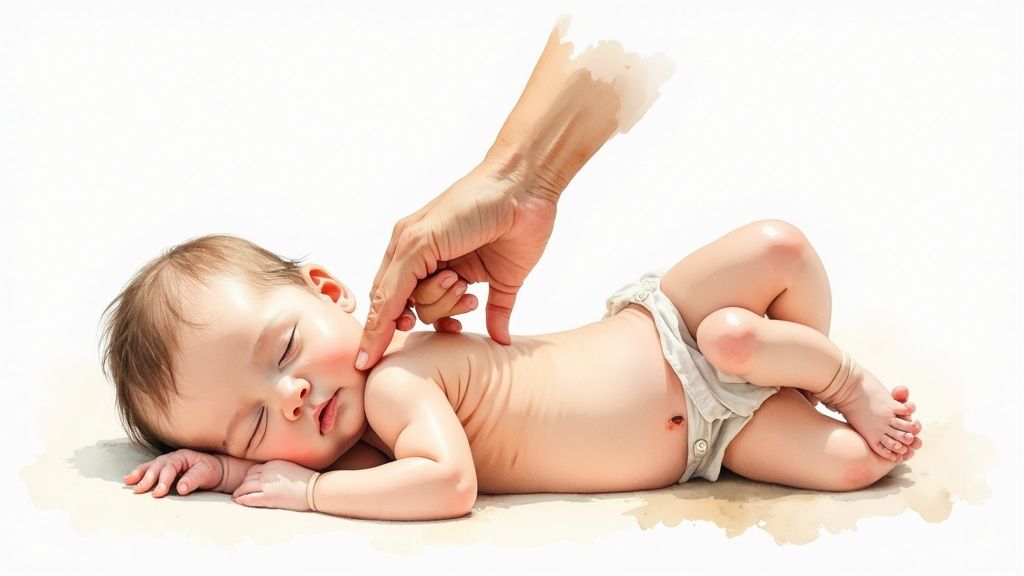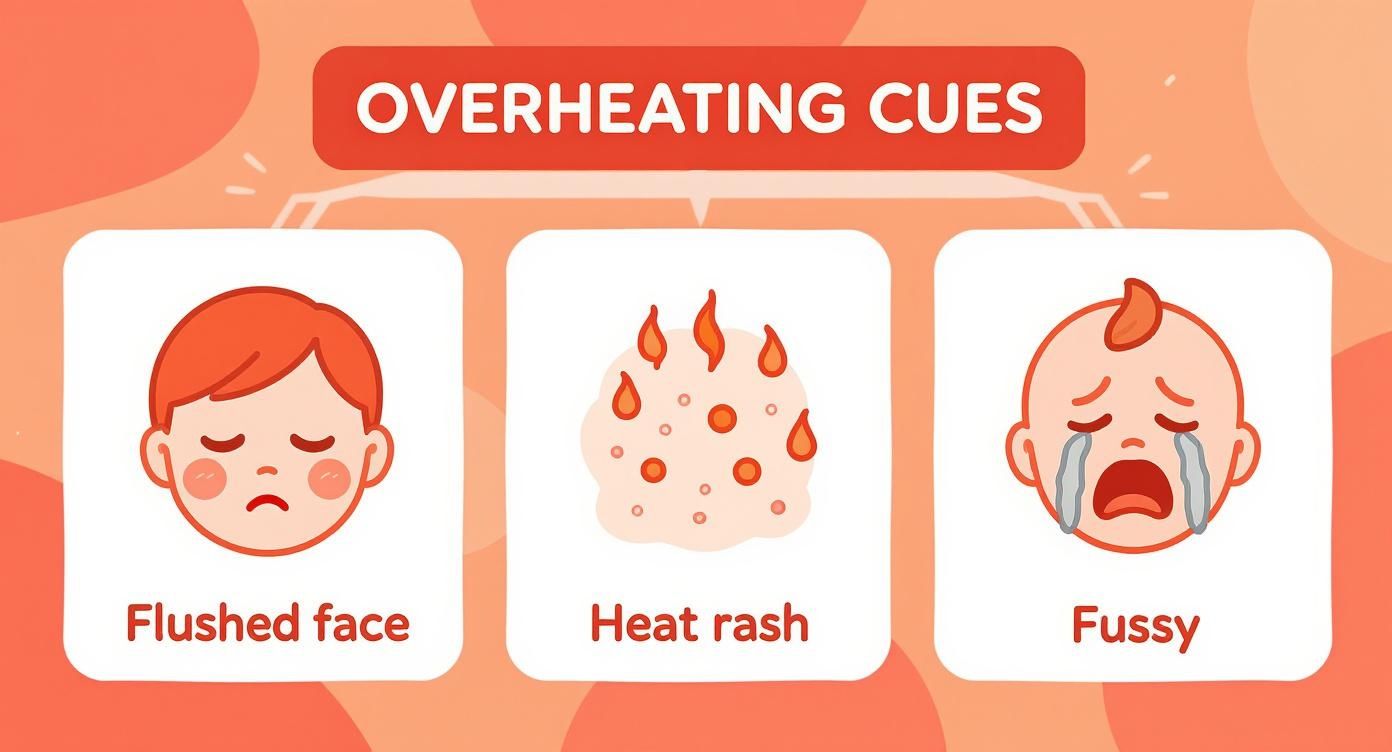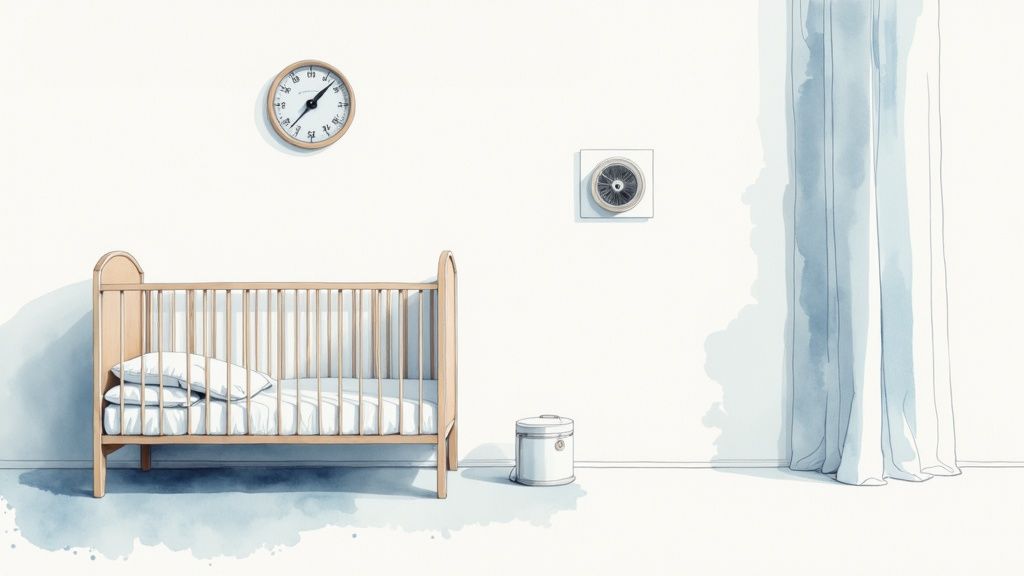Knowing how to tell if a baby is too hot often starts with a simple, intuitive check you can do in seconds. Gently feel the skin on the back of their neck or their tummy. If it feels hot or sweaty, they're probably a bit too warm. It’s a worry every new parent has, but this quick check is the most reliable way to gauge their core body temperature.
Your Quick Guide to Checking Baby's Temperature
As a new parent, you’re learning a whole new language—your baby’s cues. Keeping them safe and comfortable is your top priority, and we're here to help you feel confident. Because their tiny bodies are still mastering the art of temperature regulation, they can get warm pretty easily. The good news is, they give us clear signals once we know what to look for.

The Hands-On Check
Your own touch is the quickest tool you have. It's tempting to feel their hands or feet, but those are often naturally cooler because their circulatory system is still developing. For a more accurate reading, always check their core.
Place the back of your hand on the nape of their neck or their little back. If their skin feels warm and dry, they're likely just right. If you feel any dampness or sweat, that’s a sure sign to peel off a layer of clothing. This simple adjustment is often all it takes.
Reading the Visual Cues
Beyond the touch test, your baby's appearance and behavior can tell you a lot. Pay attention to these visual clues that might signal they're feeling the heat:
- Flushed Cheeks: A healthy rosy glow is normal, but a deeper, blotchy redness on their face can be a sign of overheating.
- Rapid Breathing: If their breathing seems faster or more shallow than usual, it could be their body working overtime to cool down.
- Heat Rash: Keep an eye out for clusters of tiny red bumps. These often pop up in skin folds around the neck, in the armpits, or near the diaper area where sweat gets trapped.
A baby who is too warm might also be fussier than usual or, on the flip side, seem surprisingly sleepy. You know your baby best. If something just feels off, it’s always worth a closer look.
To make it even easier, here’s a quick summary of the signs to watch for.
Quick Signs Your Baby Might Be Too Hot
| Sign to Check | What to Look For | What It Means |
|---|---|---|
| Skin Touch | Neck or back feels hot or sweaty. | Their core body temperature is too high; time to remove a layer. |
| Appearance | Flushed, red face or blotchy skin. | Their body is trying hard to cool down by bringing blood to the skin. |
| Breathing | Breathing seems faster or more shallow than normal. | Increased respiratory rate is a common response to being too warm. |
| Behavior | Unusual irritability, fussiness, or lethargy. | Discomfort from heat can affect their mood and energy levels. |
| Skin Condition | Tiny red bumps (heat rash) in skin folds. | Trapped sweat is irritating the skin, a clear sign of excess heat. |
Keeping these signs in mind can help you respond quickly and keep your little one comfortable and safe.
Understanding these signals is about more than just comfort—it’s crucial for your baby's safety, especially during sleep. Research has consistently shown a strong connection between overheating and an increased risk of Sudden Infant Death Syndrome (SIDS). This makes monitoring your baby’s temperature not just a matter of comfort, but a key part of safe sleep. You can learn more about these important findings on infant safety from studies on the topic.
Learning Your Baby's Overheating Cues
It goes way beyond just a quick touch test. Your baby has a whole language to tell you they're too warm, and learning to read those cues means you can act fast, long before they get truly distressed.
Think of it this way: their little body is already working hard to cool itself down. The flushed skin, the fussiness, the sweat—those are just the outward signs of that internal system kicking into high gear. By tuning into these signals, you'll know exactly how to adjust their clothes or the room to keep them safe and happy.
Reading Their Body Language
One of the first things you'll probably notice is their skin. A warm, content baby often has a soft, rosy glow. But an overheated baby? That's a different story. Look for a much deeper, more intense flush, especially on their face, neck, and chest. It's not just a cute blush; it’s a sign their body is pushing blood to the surface to release heat.
Another dead giveaway is heat rash, sometimes called prickly heat. It shows up as tiny red bumps, almost like little pimples, and it loves to pop up in places where sweat gets trapped.
You'll most often spot it:
- In the folds of their neck
- Under their little arms
- Around the diaper line
- Across their upper chest or back
Seeing that rash is a clear signal their skin is struggling to breathe and is getting irritated from the trapped moisture.
Listening to Their Behavior
Often, the clearest signs have nothing to do with how they look and everything to do with how they act. An overheated baby is almost always an unhappy baby. They can become incredibly fussy or irritable for what seems like no reason at all. If they're suddenly fighting sleep or waking up constantly, being too warm is a very common culprit.
On the flip side, some babies do the complete opposite. They can become unusually quiet and lethargic. If your normally busy baby suddenly seems listless, floppy, or excessively sleepy, it could mean their body is overwhelmed trying to cool down. A major shift in their energy level is definitely a cue you want to pay attention to.
Parent Tip: You know your baby best. A sudden, out-of-character change in their mood—whether that means more crying or way less activity—is often your first clue that something isn't right. Heat is one of the most common and easiest things to check for first.
Monitoring Their Breathing and Heart Rate
There are a few other, more subtle physical signs you can check for. Place your hand gently on their chest. Does their heart seem to be beating a bit faster than normal? Is their breathing a little more rapid or shallow? These can be signs their body is working harder to expel heat.
For instance, you might notice their little chest rising and falling more quickly after they’ve been bundled up in a car seat or snuggled in their bassinet for a while. This isn't always a cause for panic, but when you see it along with other signs like a sweaty neck or flushed cheeks, you've got a clear picture. Seeing these signals together gives you the confidence to know it’s time to help them cool down.
Dressing Your Baby for Comfort Day and Night
Figuring out what your baby should wear can feel like a guessing game, can't it? You have this adorable pile of onesies and sleepers, but how do you know if you're hitting that "just right" level of coziness without making them too hot? It's a common worry for every parent.
A simple, parent-tested rule of thumb is to dress your baby in one more light layer than you’re comfortably wearing. This little trick helps make up for the fact that babies, especially newborns, are still learning how to regulate their own body temperature.
This infographic is a great visual guide for the kind of cues you can look for.

Keeping an eye out for these signs—like a flushed face, a bit of heat rash, or more fussiness than usual—can give you a quick confirmation that it's time to peel off a layer.
Daytime Dressing Made Simple
When you're just hanging out at home during the day, let the room's temperature be your guide. If you’re comfortable in a t-shirt, your baby will probably be perfectly happy in a lightweight, long-sleeved onesie. Feel like you need a light sweater? They might be coziest in a onesie with a pair of soft pants.
The real key here is choosing fabrics that breathe. Materials like organic cotton and bamboo are your best friends—they’re incredibly soft on sensitive skin and let air flow freely, which is a lifesaver for preventing trapped sweat and that dreaded heat rash.
Bedtime Layers and TOG Ratings
Dressing your baby for sleep follows the same logic, but with an extra layer of safety. Since loose blankets are a major no-go in the crib for babies under 12 months, a sleep sack (or a wearable blanket) is the perfect, safe solution.
This is where you'll hear about TOG ratings. A TOG (Thermal Overall Grade) rating is just a simple way to know how warm a sleep sack is. The lower the TOG, the lighter it is; the higher the TOG, the cozier and warmer it will be.
Here’s a quick cheat sheet to make it easy:
- Warm Room (75-81°F / 24-27°C): Go for a 0.5 TOG sleep sack. It's basically like a light cotton sheet. Your baby might only need a short-sleeved onesie underneath.
- Standard Room (68-74°F / 20-23°C): A 1.0 TOG is your year-round workhorse. This is a super versatile option that pairs perfectly with a long-sleeved onesie or cotton jammies.
- Cool Room (61-67°F / 16-19°C): A 2.5 TOG sleep sack is what you'll want for extra warmth. Think of it as a quilted, thicker wearable blanket, perfect for colder nights when paired with warm, footed pajamas.
Picking the right sleep sack isn't just about warmth; it's about giving them safe, breathable comfort all night long. A great one keeps your baby snug without any risk of overheating or loose bedding.
For example, on a mild evening, a 1.0 TOG sleep sack over a simple cotton pajama set is a fantastic combo. For those chilly winter nights, you might put them in fleece pajamas under a 2.5 TOG sleep sack to keep them toasty warm. Finding a soft cotton and bamboo baby sleeping bag can provide that safe, breathable warmth you’re looking for. It takes the guesswork out of it, so you can rest easy knowing they're at a safe and comfy temperature until morning.
Creating a Cool and Safe Sleep Space
Your baby’s room should feel like a peaceful little haven, and getting the temperature just right is a huge part of that. Keeping their sleep space cool and safe isn't just about comfort—it's one of the most important things you can do to prevent overheating and help them rest soundly.

This is a critical safety measure, especially with global temperatures on the rise. In Europe and Central Asia, for example, increasing heat has led to more heat-related child deaths. An estimated 377 children died from these illnesses in 2021 alone. Tragically, about half of those deaths were babies in their first year of life, which just goes to show how incredibly vulnerable our little ones are. You can read more about these crucial UNICEF findings to get the full picture.
Finding the Sweet Spot for Sleep
So, what's that magic number for the nursery thermostat? Most pediatric experts agree that the ideal room temperature for a baby is between 68-72°F (20-22°C). It’s a range that’s cool enough to lower the risk of overheating but still perfectly cozy for sleep.
A simple digital room thermometer is an absolute must-have for the nursery. It takes all the guesswork out of the equation and gives you an accurate reading at a glance.
Here are a couple of practical tips for keeping the room in that sweet spot:
- Use a Fan: A fan is fantastic for circulating air and creating a gentle breeze. The key is to make sure it’s not blowing directly on your baby. An oscillating fan placed on the other side of the room works wonders.
- Block Out the Sun: On hot, sunny days, blackout curtains are a total game-changer. They don't just help with daytime naps; they also block a surprising amount of heat from seeping in and warming up the room.
The Golden Rules of Safe Sleep
Of course, a safe sleep environment goes beyond just the temperature. A cool room needs to be paired with a safe crib setup to truly protect your little one. The goal here is to keep their sleep space as minimal and breathable as possible.
The safest crib is a simple one. All your baby really needs is a firm mattress with a snug-fitting sheet. Anything extra can actually pose a risk.
This means absolutely no loose blankets, pillows, bumpers, or fluffy toys in the crib. These items can easily trap heat around your baby's face and body, which increases the risk of both overheating and suffocation.
If you’re worried about them getting chilly, a wearable blanket or a sleep sack is the safest—and coziest—choice. We designed our collection of breathable sleepwear essentials with this in mind. It keeps them snug and secure without the dangers of loose bedding.
When you combine a cool room with a clear crib, you’re creating the safest possible space for your baby to dream.
Knowing When to Call Your Pediatrician
As a parent, your intuition is one of your best tools. While most of the time, figuring out how to tell if baby is too hot is a simple case of checking their skin and making a quick adjustment, it's just as crucial to know when a situation has moved beyond a simple fix.
Most cases of a baby being a bit too warm are easily sorted out—just peel off a layer or move to a cooler spot. But sometimes, their tiny bodies can get overwhelmed, leading to something more serious like heat exhaustion. Knowing the difference empowers you to act fast when it really matters.
Red Flags That Need a Doctor's Attention
If your baby is just a little overheated, they should start to cool down and get back to their normal, happy self within about 30 minutes of you making things cooler for them. If their symptoms aren't getting better, or if you spot any of the following signs, it's time to call the doctor right away.
These are the signals that you need to take more seriously:
- A High Temperature: For a baby under 3 months old, a rectal temperature of 100.4°F (38°C) or higher is always a reason to call your pediatrician.
- Extreme Lethargy or Unresponsiveness: If your baby seems unusually floppy, weak, or is really difficult to wake up, that's a major red flag.
- Vomiting: We all know spit-up is normal, but forceful or repeated vomiting could mean something more is going on.
- Refusing to Eat or Drink: A sudden disinterest in feeding is a key indicator that your baby isn't feeling well.
Watching for Signs of Dehydration
Overheating and dehydration often go hand in hand. A baby’s body is about 75% water, so they can lose essential fluids alarmingly fast.
Your baby's hydration is a direct window into their overall health. If you see signs of dehydration, don't hesitate—seek medical advice immediately.
Keep a close eye out for these specific signs that your little one might be getting dehydrated:
- Fewer Wet Diapers: Are you changing diapers less often? Fewer than six wet diapers over a 24-hour period is a classic warning sign.
- No Tears When Crying: If your baby is clearly upset but there are no tears, that’s a sign their body is conserving fluids.
- A Sunken "Soft Spot": The fontanelle, that soft spot on the top of your baby's head, might look sunken or indented.
- Dry Mouth and Lips: Their mouth might feel sticky or look visibly dry.
Spotting these symptoms is becoming more critical as our world gets warmer, making heat-related illnesses a real and growing concern for infants. A recent study actually showed that a significant number of neonatal deaths were tied to non-optimal temperatures, which just underscores how vulnerable babies are. You can read the full research on climate impacts on infant health for more details.
If you notice any of these symptoms, don't wait and wonder. Call your pediatrician right away. They can give you the best advice for your baby and guide you on exactly what to do next.
Common Questions from New Parents
Being a new parent means having a million questions pop into your head at all hours of the day and night. It’s totally normal, and trust us, you're not alone in wondering about these things. We've put together answers to some of the most common worries we hear from parents just like you.
Is It Okay if My Baby’s Hands and Feet Are Cold?
Yes, this is probably the number one question we get! It’s completely normal for a baby's hands and feet to feel a bit chilly. Their brand-new circulatory system is still figuring things out, so it sends most of the warm blood to their core and vital organs first.
To get a real sense of how warm they are, gently touch the back of their neck or their tummy. If that area feels comfortably warm and dry (not sweaty), your baby is doing just fine, even if their little fingers and toes feel cool.
Can We Use a Fan in the Baby's Room?
Absolutely. A fan is a great way to keep the air moving in the nursery, which is key to preventing the room from getting stuffy and hot. In fact, good air circulation is often recommended as it can help reduce the risk of SIDS.
The trick is to make sure the fan isn't blowing directly onto your baby. You're aiming for gentle air movement, not a wind tunnel. An oscillating fan on a low setting, placed across the room, usually works perfectly.
How Do I Stop My Baby from Getting Too Hot in the Car Seat?
Car seats can get surprisingly toasty, especially when the sun is beating down. A little planning goes a long way here. Start by running the car's AC for a few minutes before you put your baby in their seat. Those pull-down window shades are also a lifesaver for blocking direct sun.
When you're getting them ready, stick to a single, lightweight layer made from a breathable fabric. And this is the big one: never, ever leave your baby alone in a car, not even for a second. The temperature inside a vehicle can skyrocket in just a few minutes.
What’s the Best Way to Handle a Heat Rash?
First, don't panic! Heat rash (sometimes called prickly heat) looks like tiny red bumps, and it happens when sweat glands get clogged. The best fix is simply to cool your baby down. A quick, lukewarm bath can feel amazing and provide instant relief.
After the bath, let their skin air dry for a bit before dressing them in loose, light clothing. The rash usually disappears on its own within a day or two. For more practical advice, you can find more answers to common parent questions on our site to help you feel even more prepared.
At Mimou Babywear, we know that keeping your baby comfortable starts with what’s next to their skin. Our collections are made from the softest, most breathable fabrics, designed with your little one’s safety and coziness in mind. Shop our babywear at https://mimoubabywear.com.
Article created using Outrank





